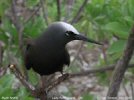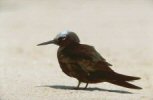Mangoverde :: World Bird Guide :: Terns :: Black Noddy
Black Noddy Anous minutus
Described by: Boie (1844)
Alternate common name(s): White-capped Noddy
Old scientific name(s): None known by website authors
Photographs


Select thumbnail to view larger image - Place cursor over image for image information
Range
Tropical Atlantic and Pacific Oceans; Two main populations; (1) E. Pacific Ocean at Clipperton Is. and Cocos Is. off Costa Rica. (2) Caribbean coasts including Is. off Central America (Southwest Cay off Belize and recently is. off Yucatan Peninsula, Mexico) and Venezuela (Los Roques and possibly Las Aves). Recently recorded in the Lesser Antilles. (3) Tropical s. Atlantic is. (St. Peter and St. Paul's Rocks, Fernando de Naronha, Ascension, St. Helena and formerly Tristan da Cunha on Inaccessible Is.) and Gulf of Guinea (Principe). (4) Cavilli Is. and Tubbataha Reef in the Sulu Sea. Belitung (Kebuantuan Is.) and Borneo. (5) Is. from New Guinea and ne. Australia (Northern Territory, Queensland (Great Barrier Reef islands including Lady Elliot Island, Musgrave Island, Heron Island and Michaelmas Cay) and n. New South Wales), Norfolk Is., Fiji, Tonga (Kalau) to the Tuamotu Archipelago. Fiji birds disperse up to 2900km w. through the Solomon Is. (6) Philippines, Palau, Marcus and Wake Is. through Micronesia to the Caroline Is. (7) Hawaiian Is. (frequently at ocean cliffs at Hawaii Volcanoes National Park). ___________________________________________________________________________________
North America n. of Mexican border;
Summer: recorded only from ex. s. FLA (Dry Tortugas).
Videos
No videos are available for this species
Sounds
No sounds are available for this species
References
Clements, James F. Birds of the World: A Checklist. Vista, CA: Ibis Publishing Company, 2000.
Comments/Errors
Please email with errors/comments on this page or to donate photos.
If there is no family list to the left, you may have arrived at this page from a direct link.
Please select "Mangoverde World Bird Guide" to view the entire bird site.



